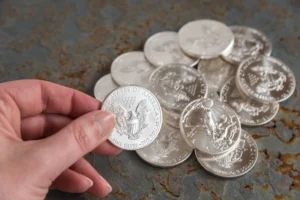The Silver Price Drop of 2025 has captured global attention after prices fell nearly 17% in just ten days. For a metal that had been on an unstoppable upward rally through much of the year, this sudden fall signals a powerful shift in market sentiment. Traders, investors, and analysts are now asking what caused the decline and whether it reflects a temporary correction or the beginning of a longer downtrend.
Silver’s position as both an investment and industrial commodity makes it uniquely reactive to multiple market forces. From inflation expectations to supply changes and profit-taking, several intertwined factors drove this correction. The latest Silver Market Correction highlights how quickly enthusiasm can turn into caution once fundamentals and positioning collide.
While the fall surprised many, it also reflects the market’s natural self-balancing mechanism. After an overheated rally driven by limited supply, speculative flows, and strong industrial optimism, the stage was set for a reset. As inventories rose, safe-haven demand weakened, and traders booked profits, silver faced a multi-layered correction.
This article breaks down the reasons for the silver price fall, focusing on the silver supply surge impact and widespread profit booking in the silver market, which together triggered one of the sharpest price swings seen recently.

The Sudden Silver Market Correction
The Silver Market Correction in 2025 stands out for its speed, depth, and timing. After reaching record highs earlier in the year, silver lost nearly one-fifth of its value in less than two weeks. Prices dropped from around $54 per ounce to below $48 internationally, while in India, rates slid from ₹1.78 lakh to ₹1.47 lakh per kilogram.
Such a steep fall doesn’t occur randomly. It followed an extended period of optimism built on constrained supply, strong physical demand, and heightened investor interest. When any of those pillars shift, the market reacts violently.
In this case, improved delivery from miners and refiners reduced scarcity pressure. As availability improved, speculative positions started unwinding. Traders who had accumulated long positions during the rally began exiting to preserve profits. That sparked a feedback loop: as prices fell, more traders sold to protect gains, accelerating the drop.
The correction also aligned with seasonal slowdowns. Industrial demand, especially from electronics and solar manufacturers, softened slightly due to slower production cycles. Combined with shifting macroeconomic expectations, these factors created a short-term imbalance.
However, this decline does not necessarily mark a structural downturn. Rather, the Silver Market Correction reflects a market realignment after months of overheating. It is part of a healthy cycle that removes excess speculation and re-establishes sustainable price levels.
Key Reasons for Silver Price Fall
The reasons for the silver price fall in 2025 stem from a mix of supply, sentiment, and macroeconomic factors that converged at once.
- A Sudden Supply Rebound
The Silver Supply Surge Impact was immediate. After months of tight availability, new shipments from the U.S., China, and Latin America reached major vaults in London and Asia. Improved refining and logistics reduced backlogs, calming previous fears of shortage. When supply perception shifts from “scarce” to “sufficient,” price support evaporates quickly. - Heavy Profit Booking
The rally through mid-2025 attracted speculative money from hedge funds and retail investors. Once silver touched record highs, traders began securing gains. This wave of profit booking in the silver market triggered algorithmic selling and momentum reversals, deepening the fall. - Reduced Safe-Haven Demand
Silver had benefited from inflation worries and geopolitical uncertainty. But as inflation slowed and global markets stabilized, investors rotated funds back into risk assets like equities, weakening demand for defensive metals. - Stronger U.S. Dollar
A firm dollar during this period increased the cost of dollar-denominated metals for overseas buyers. As demand fell from non-U.S. regions, silver faced added selling pressure. - Technical Market Triggers
Silver prices broke key support levels, including the 50-day and 100-day moving averages. Once breached, these technical levels triggered automated stop-loss orders that accelerated selling momentum.
Together, these reasons for the silver price fall created a synchronized correction, forcing both retail and institutional traders to adjust positions quickly.
Understanding the Silver Supply Surge Impact
The Silver Supply Surge Impact was perhaps the most powerful single factor in this correction. Fears of tight supply dominated the silver market throughout 2024 and early 2025. October marked a dramatic shift in this narrative.
New mining output from Mexico, Peru, and China entered the market, easing physical constraints. Refiners also expedited production, which had previously experienced delays earlier in the year. By mid-October, major storage hubs reported rising inventories. This improvement in supply drastically changed trader psychology.
To illustrate the effect, consider this: when physical silver premiums for delivery fall, it signals easier availability. Once that happens, buyers step back, waiting for better prices, while sellers rush to exit at current levels. This simple behavioral shift turned the earlier bullish sentiment into widespread caution.
The Silver Supply Surge Impact also affected industrial sentiment. Manufacturers who were struggling with higher input costs earlier in the year suddenly saw relief, reducing urgency to stockpile silver. As industrial demand softened temporarily, market momentum faded further.
Despite this short-term adjustment, analysts emphasize that long-term supply remains relatively constrained. Silver mining is mostly a byproduct of lead, zinc, and gold production, which limits flexibility. Thus, while this surge corrected short-term imbalances, it is unlikely to cause a lasting glut.
Profit Booking in the Silver Market: A Natural Yet Powerful Force
The next major trigger was widespread profit booking in the silver market. When prices rally too fast, traders begin taking profits, often leading to a self-reinforcing sell-off.
In this case, the process unfolded quickly. Institutional investors who had built large positions in silver-backed ETFs began offloading holdings to secure quarterly gains. Retail traders followed suit once prices dipped below short-term support zones.
This chain reaction is common in commodity markets, but silver’s volatility makes it more pronounced. As one group of sellers exits, momentum indicators trigger automated programs to do the same. A small correction can become a full-blown slide in a matter of hours.
A practical example helps illustrate this dynamic. Suppose a trader bought silver at $38 and saw it rise to $54 within months. Even a small drop to $51 would trigger selling, locking in a 34% profit. When enough traders act the same way, it multiplies the downward force.
It’s important to note that profit booking isn’t inherently negative—it reflects market health. It allows capital rotation and prevents unsustainable bubbles. In the case of the Silver Price Drop of 2025, it was the timing and volume of profit-taking, combined with improving supply, that made the fall so steep.
Macroeconomic Context of the Silver Market Correction
While the supply surge and profit-taking were immediate triggers, the Silver Market Correction also reflected broader macroeconomic adjustments.
Interest rate expectations shifted after central banks signaled slower rate cuts than previously anticipated. Higher yields on government bonds reduced the appeal of holding non-yielding assets like silver. As capital flowed back into fixed-income and equity markets, silver faced indirect selling pressure.
At the same time, a stronger U.S. dollar exerted further drag. Historically, silver and the dollar share an inverse relationship. When the dollar strengthens, commodities priced in dollars tend to weaken because they become pricier for foreign investors.
Industrial demand trends also contributed. Silver’s use in solar panels and electronics continues to rise, but short-term consumption eased slightly as manufacturers adjusted inventories. Slower growth in China’s industrial output during late Q3 further reduced immediate demand.
These macro factors combined with internal market dynamics to amplify the Silver Price Drop of 2025. However, most analysts see these as cyclical rather than structural pressures. Silver’s role in the green energy transition remains strong, suggesting that the decline may be temporary.
Short-Term vs. Long-Term Outlook
The outlook following the Silver Price Drop of 2025 requires separating short-term volatility from long-term opportunity. The correction has changed trading dynamics, but the broader trend still favors gradual recovery once the market stabilizes.
Short-Term Outlook:
In the near term, silver is expected to trade within a tight range between $47 and $51 per ounce as the market digests the recent correction. Volatility will remain elevated due to mixed sentiment among traders. Technical rebounds may occur, but each rally could face resistance until stronger buying conviction returns. Cautious optimism dominates the short-term narrative, with buyers active at lower levels and sellers using brief price spikes to exit.
Global macro conditions will continue influencing price behavior. A stronger U.S. dollar and higher real interest rates could limit upside momentum in the short run. However, if inflation pressures or geopolitical risks re-emerge, safe-haven demand could trigger quick rebounds. For traders, the focus should remain on short-term technical zones, macro headlines, and updated supply reports before taking new positions.
Long-Term Outlook:
The long-term fundamentals of silver remain robust. Industrial demand from renewable energy, electric vehicle manufacturing, and advanced electronics continues to rise. Each solar panel and EV battery relies heavily on silver, ensuring steady consumption growth. Meanwhile, global mine supply expansion remains limited due to high production costs and few new discoveries.
This structural imbalance between rising demand and slow supply growth supports silver’s recovery potential once the market stabilizes. As inflation trends and industrial cycles strengthen again, prices could reclaim previous highs. For long-term investors, the Silver Market Correction offers an attractive accumulation window—ideal for those with patience, data-driven discipline, and realistic return expectations.
What Traders Can Learn from the 2025 Correction
The Silver Price Drop 2025 is more than a market event—it’s a masterclass in trading psychology, timing, and discipline. Rapid rallies and equally sharp declines often expose weaknesses in emotional decision-making, making risk management more valuable than prediction.
Key Lessons for Traders:
- Track Real Supply and Inventory: Monitoring global inventories and shipment data helps identify turning points before prices react.
- Avoid Excessive Leverage: Silver’s volatility can magnify losses; keeping moderate position sizes ensures long-term survival.
- Plan Profits, Not Panic: Setting predefined profit targets and stop-losses prevents impulsive exits during high volatility.
- Watch Macroeconomic Triggers: Silver closely tracks movements in bond yields, inflation data, and the U.S. dollar. Staying informed allows timely adjustments.
- Think Objectively: Let data, not emotion, guide trades. Every silver market correction resets the playing field and creates new opportunities for disciplined traders.
By applying these principles, traders can turn volatility into strategy rather than stress. The recent correction reminds everyone that preparation, patience, and perspective are the real edges in commodity markets.
Frequently Asked Questions (FAQ)
Q1. What caused the Silver Price Drop of 2025?
The Silver Price Drop 2025 was triggered by an unexpected Silver Supply Surge Impact, heavy profit booking in the silver market, and shifting global sentiment. Increased supply from major producers eased earlier shortages, while investors booked profits after months of gains, leading to a swift silver market correction.
Q2. How severe is this silver market correction?
The 17% fall in ten days is sharp but not alarming. It reflects a short-term adjustment after an overheated rally, not a long-term collapse. Silver markets often experience such volatility before stabilizing.
Q3. Will silver prices recover in 2025?
Yes. Analysts expect prices to stabilize as supply balances and demand from industrial sectors like solar and electronics stays strong. Once sentiment improves, a gradual recovery is likely.
Q4. Should investors buy silver after this correction?
For long-term investors, this dip may offer a strategic entry point. However, short-term traders should wait for confirmed trend reversals before re-entering positions.
Q5. What’s the outlook for silver beyond 2025?
The long-term outlook remains positive. Silver’s demand in renewable energy, electric vehicles, and technology ensures continued relevance, while limited new mining projects may support higher prices ahead.
Conclusion
The Silver Price Drop of 2025 serves as a classic example of how global markets balance themselves. A sharp silver supply surge impact combined with heavy profit booking in the silver market created the perfect storm for a 17% decline.
Yet, corrections like this are normal. They eliminate excess speculation, reset sentiment, and prepare markets for sustainable growth. Silver’s long-term fundamentals—industrial utility, limited mining expansion, and ongoing demand from clean energy—remain intact.
For now, traders should focus on data, discipline, and timing. The next bullish phase will best position those who understand the rhythm of corrections and rebounds.
The white metal may have lost some shine in the short term, but its long-term brilliance is far from over. The Silver Market Correction of 2025 may just be a pause before the next major rally.
Read here to learn more about “Top 10 ETFs for Day Trading You Shouldn’t Miss This Year“

I’m Chaitali Sethi — a seasoned financial writer and strategist specializing in Forex trading, market behavior, and trader psychology. With a deep understanding of global markets and economic trends, I simplify complex financial concepts into clear, actionable insights that empower traders at every level. Whether it’s dissecting winning strategies, breaking down market sentiment, or helping traders build the right mindset, my content bridges the gap between information and implementation.




